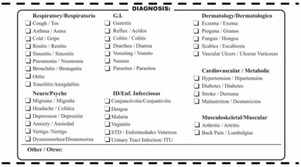What is a brigade?!
Location and Setup
The physical site of the medical brigade and details of setup will vary depending on the community and available resources. Most often, the site will be a school or church in the village. Spatial areas or different rooms will be designated for distinct functions.
Similarly to a traditional hospital, patients will be transitioned from intake, to triage, to a consultation, and ultimately the pharmacy (all of which will be run by our groups volunteers).
- take blood pressure for those over 40
- weigh children under 12
- take temperature of children under 12 and those who claim a fever
If a doctor comes across an ailment they feel the brigade does not have the proper medication/ equipment to address, that doctor can refer the patient to the Clinica Santa Rosa de Lima for further treatment provided free of cost by Global Medical Brigades. ONLY the doctors can write in this part of the patient sheet:
If a referral is given, the bottom right corner of the patient sheet, shown above, must be cut out and given to the patient for them to take with them to Clinica Lima.
Runners: When the pharmacy runs out of a certain type of medicine, a few runners are designated to go update the doctors’ medicine inventory lists (which they use to prescribe). After the brigade, runners should ensure that all medicine inventory lists match (some will be in the pharmacy, others in the clinic). This way, doctors are not prescribing medicines that you do not have. Runners also refresh supplies that will be needed in triage and the consultation room, such as gloves, hand sanitizer, etc.
4. Pharmacy: In this station, prescriptions are filled with either a doctor or pharmacist to approve the finished products and answer volunteers’ questions. Considered by some to be the most high-energy station, volunteers in pharmacy should be prepared for long, fast-paced days. It will behoove the pharmacy to consider how best to set up the pharmacy on the first day (ex: vitamins and anti-parasite meds by the door since these will be most common), and continue this set-up each day to minimize the time spent searching for a correct medicine. Place all prescriptions for the same patient in one plastic bag. Keeping family’s patient sheets together is important, so they don’t wait on one person’s medicine for a long time. No Spanish is required for this station.
Medicine Directions: Translators are responsible for giving patients their medicine and relaying its corresponding instructions. Spanish skills are crucial for conveying complex directions for certain medications. However, those with no Spanish speaking skills can also participate by learning the basic phrases (ex: Take one vitamin a day = Tome una vitamina cada dia) for the most common, simple medications given.
*Once Medicine is given to a patient, they must NOT walk away with their patient sheet. Walk the sheets over to the Data Entry station for processing.
Crowd Control: These are the volunteers who direct traffic from one station to the next and maintain a sense of order within the brigade. Medical brigades vary in size but can involve treating several hundred patients in one day, making crowd control an essential part of the brigade machine. (In many situations the local Honduran workers will step in and reestablish order if necessary.)
Extra Positions: Extra positions depend on the size of the volunteer group. Volunteers to entertain the many children of the brigades, whether through crafts, games or toys, are always needed. Additionally, stations are often set up based upon specific careers or skills that volunteers possess. If for example a physical therapist or audiologist comes to volunteer, they can create their own station to address patients’ specific problems, or conduct hearing tests.





